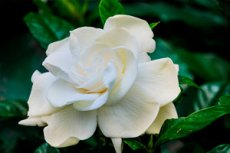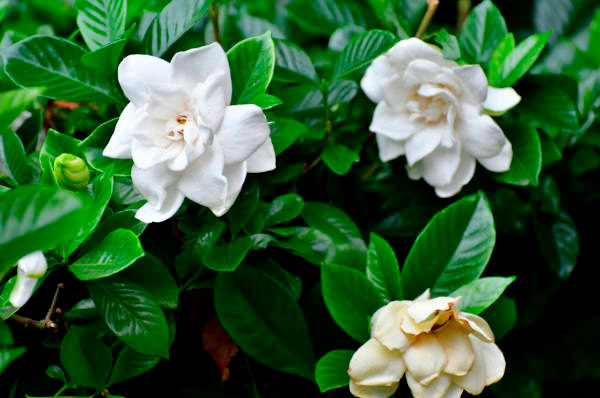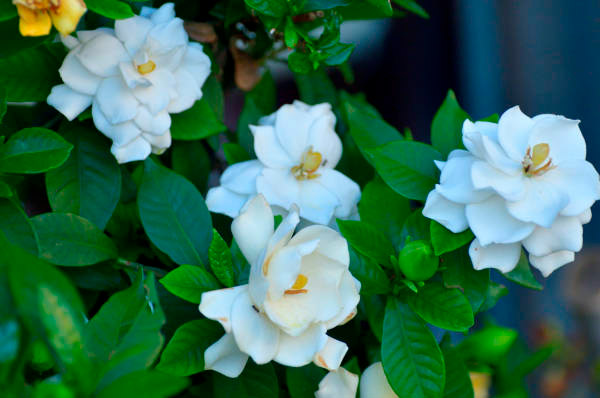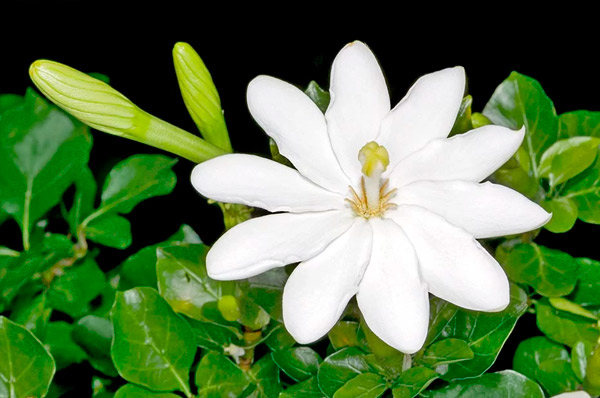New publications
Plants
Gardenia
Last reviewed: 11.03.2025

Gardenia (lat. Gardenia) is a genus of flowering plants in the Rubiaceae family, comprising more than 140 species. These plants are known for their large, fragrant white or cream flowers, which are often used in decorative horticulture. Gardenia is an evergreen shrub that can grow from 30 cm to 1 meter in height, depending on the species. The flowers of gardenia are not only visually appealing but also emit a strong, sweet fragrance, making them popular in the perfume industry. Due to their aesthetic qualities, gardenias are used both as houseplants and in garden compositions.
Plants of the genus Gardenia prefer warm and humid climates and are commonly found in tropical and subtropical regions such as South Asia and Africa. Additionally, gardenias require special care and conditions, making them somewhat challenging to grow, but their beauty and fragrance compensate for the difficulties.
Etymology of the name
The genus name Gardenia was given in honor of the Scottish botanist Alexander Garden, who was known for his studies of the flora of South Africa. This name was introduced in the 18th century when gardenia was first described as a distinct genus. Its selection highlights Garden's contribution to plant studies and also symbolizes the significance of this genus in botanical science.
The etymology also reflects the characteristics of plants in this genus, their beauty, and their value in decorative horticulture. Gardenia has become not only an important subject of botanical research but also a symbol of refined and sophisticated aesthetics in gardening and landscape design.
Life form
Gardenia is a perennial plant that can be either a shrub or a small tree, depending on the growing conditions. The plants in this genus feature evergreen foliage that retains its color throughout the year, as well as beautiful white or cream flowers that bloom abundantly during the warm season. These plants also have specific humidity and temperature requirements, which make them more suitable for greenhouse or indoor cultivation.
The shrub form of gardenia is characterized by branching stems and a compact crown, which can be shaped into various decorative forms, such as upright or more bushy plants. Its root system is well-developed, providing stability for the plant and enabling it to absorb the necessary nutrients.
Family
Gardenia belongs to the Rubiaceae family, which includes more than 13,000 species, including both trees and shrubs. The family is known for its wide diversity of species, many of which are important in agriculture and horticulture. Notable genera include the coffee tree, chionanthus, and various species of gardenias, which are famous for their ornamental flowers and fragrances.
Plants in the Rubiaceae family generally have bright, attractive flowers, which can be white, yellow, or red. These plants are often found in tropical and subtropical regions and can have both economic and cultural significance for humans.
Botanical characteristics
Gardenia is characterized by dark, glossy leaves that can grow up to 15 cm long and about 5 cm wide. The leaves are usually arranged oppositely on the stems and form a dense foliage mass. Gardenia flowers are large, up to 10 cm in diameter, white or cream with a strong sweet fragrance, and are typically arranged in solitary inflorescences. The flowers may be either simple or more complex in structure.
Flowering occurs in the summer, but under optimal conditions, gardenias can bloom year-round in indoor settings. It is important to note that flowering may be reduced or halted under stressful conditions, such as low temperatures or improper care. The fruit of the plant is a two-chambered capsule containing numerous small seeds.

Chemical composition
Like many plants in the Rubiaceae family, gardenia contains various biologically active substances, including iridoids, flavonoids, and essential oils, which are responsible for the characteristic fragrance of the flowers. Essential oils from gardenia are often used in the perfume industry due to their strong and pleasant scent.
Additionally, the plant contains substances with antiseptic, anti-inflammatory, and antioxidant properties. Some studies suggest that extracts from gardenia may have beneficial effects in treating skin conditions, such as eczema, as well as inflammation. However, it is important to note that high doses of extracts may be toxic, so their use for medicinal purposes should be under professional supervision.
Origin
Gardenia is native to the tropical and subtropical regions of Asia and Africa, specifically countries such as China, Japan, and India. These plants are often found in humid forests, on mountain slopes, or along riverbanks, where they can receive an adequate amount of water and nutrients.
With the development of horticulture, gardenia has been cultivated and adapted for growth in other regions, including Europe and North America, where it has become a popular ornamental plant, grown both in greenhouses and in homes.
Ease of growing
Gardenia requires specific conditions for successful growth, making it somewhat challenging to care for. It prefers high humidity, warmth, and bright but diffused light. Under these conditions, gardenia can grow and bloom easily. However, it is quite sensitive to temperature fluctuations and does not tolerate cold drafts, which must be considered when placing the plant.
The plant also requires regular watering and monitoring of soil moisture levels, as it does not tolerate soil dryness but also cannot stand stagnant water. Additionally, to maintain the health of the gardenia, it needs regular fertilization during periods of active growth and flowering.
Species, varieties
Among the species of gardenias, the most popular are Gardenia jasminoides, known for its aromatic white flowers, and Gardenia thunbergia, which is more commonly found in nature and has smaller flowers. There are many varieties developed for ornamental use, including hybrids with improved characteristics, such as better disease resistance and optimized blooming.
The varieties of gardenia differ in flower size, fragrance intensity, and shrub structure. Some varieties have been developed to adapt to different climate conditions, allowing them to be successfully grown in colder regions using greenhouses.

Gardenia jasminoides
Size
The size of gardenia depends on the species and growing conditions. In natural settings, shrubs can reach up to 2 meters in height, but in indoor environments, gardenias typically grow to about 1 meter. Its size also depends on soil type, lighting, and other conditions. In pots, the plants usually do not exceed 50–60 cm in height.
The size of the plant significantly influences the intensity of care. If the plant is properly shaped and has enough space to grow, it can increase significantly in size, forming a dense crown with bright flowers.
Growth rate
Gardenia has a moderate growth rate, especially under conditions that closely resemble its natural habitat. During the active growth period, which usually lasts from spring to autumn, it can grow up to 15–20 cm per month with good lighting and optimal conditions. In winter, growth slows down, and the plant enters a dormant phase.
To stimulate intense growth, it is important to provide the plant with sufficient light, stable temperatures, and regular fertilization. Improper care, lack of light, or water can significantly slow the growth of gardenia and affect its flowering.
Lifespan
Gardenia is a perennial plant that can live for up to 10 years or more with proper care. However, as the plant ages, it may require repotting to refresh the soil and provide additional nutrients. If the plant receives the necessary water, light, and temperature, it will continue to delight its owners with beautiful flowers for many years.
The plant's lifespan also depends on its health. If it undergoes stress, such as improper care, pests, or diseases, its lifespan may be significantly shortened.
Temperature
Gardenia prefers warm, moderate temperatures, within the range of 18–25°C during the active growing season. Cold temperatures below 15°C can slow down the plant's growth or cause damage. It is important to avoid sharp temperature fluctuations and drafts, which can cause stress to the plant and halt flowering.
In winter, gardenia should also be protected from cold, and higher temperatures should be maintained to prevent plant damage.
Humidity
Gardenia requires high humidity, between 60–80%. It does not tolerate dry air, especially during the heating season when indoor humidity levels drop significantly. To maintain optimal humidity, it is recommended to use humidifiers or regularly mist the plant.
Low humidity can lead to bud drop, yellowing leaves, and other problems. It is essential to monitor the humidity level in the room and avoid air dryness.
Lighting and room placement
Gardenia prefers bright, diffused light. It cannot tolerate direct sunlight, as this can cause burns on the leaves. The optimal placement for gardenia is on a window facing east or west, where it will receive enough light but be shielded from the direct rays of the sun.
In winter, when the days are shorter, gardenia may require additional lighting to maintain active blooming. Using grow lights or other light sources will help the plant continue to develop and flower under limited sunlight conditions.
Soil and substrate
For optimal growth, Gardenia requires well-drained, nutrient-rich, and slightly acidic soil. The ideal soil mix for Gardenia consists of garden soil, peat, sand, and perlite in a 2:1:1:1 ratio. This combination ensures proper root aeration, preventing root rot while retaining the necessary moisture for plant growth. Perlite and sand improve drainage, which is important to prevent water stagnation in the soil, as it can lead to root rot.
Gardenia thrives in soil with a pH level between 5.5 and 6.5, which is slightly acidic. This acidity helps the plant absorb nutrients more effectively. To further enhance drainage and ensure air permeability, a layer of expanded clay or small gravel can be added at the bottom of the pot, preventing water accumulation in the container and protecting the roots from rot.
Watering (summer and winter)
During the summer, Gardenia requires regular but moderate watering. The soil should remain moist but not overly saturated with water, as this can lead to root rot. It is recommended to water the plant when the top layer of soil begins to dry out, but it is important to avoid letting excess water remain in the saucer or pot. Using pots with good drainage holes is essential to ensure the excess moisture can drain freely.
In winter, watering should be reduced as the plant enters its dormant phase and requires less water. The soil should dry out slightly between waterings to prevent overwatering. It is crucial to monitor the watering frequency based on room temperature and humidity to prevent fungal diseases and root rot.
Fertilization and feeding
To stimulate growth and flowering, Gardenia should be regularly fertilized from spring to autumn. Balanced liquid fertilizers with high phosphorus and potassium content are recommended as they promote flower formation and support the plant's health. Fertilizer should be applied every 2–3 weeks, dissolved in watering water to avoid root burns and ensure the plant receives the necessary micronutrients.
During the winter, no fertilization is needed as the plant is in a resting phase. Ceasing feeding during this time helps avoid the accumulation of salts in the soil, which can disrupt nutrient absorption. Fertilization should resume in the spring when the plant begins to grow actively, helping to stimulate blooming and recovery.
Flowering
Gardenia begins to bloom in the warmer months, typically from spring to summer, producing large white or creamy flowers with a strong sweet fragrance. The flowering period can last for several weeks, and under optimal conditions, it can occur multiple times a year. The flowers are arranged in single clusters and attract not only pollinators such as bees and butterflies but also humans with their fragrance.
To ensure prolonged and abundant blooming, it is essential to maintain regular watering, provide adequate lighting, and carry out timely fertilization. Insufficient light or improper care may result in weak blooming or complete cessation of the flowering process.

Gardenia thunbergia
Propagation
Gardenia can be propagated both by seeds and vegetatively. Seed propagation is a lengthy process that requires high humidity and warm conditions. Seeds are sown in light, moist soil at temperatures between 22-25°C, and germinate within 2–3 weeks. However, plants grown from seeds typically bloom after 2–3 years, making this method less ideal for gardeners who want to see blooming plants quickly.
Vegetative propagation by cuttings is a faster and more reliable method. Healthy shoots are selected and placed in a mixture of sand and perlite for rooting. Cuttings typically root within 2–3 weeks, and this method ensures that the characteristics of the parent plant are preserved. Vegetative propagation also allows gardeners to quickly obtain new decorative specimens.
Seasonal features
During the spring and summer months, Gardenia actively grows and requires regular watering, feeding, and good lighting for healthy growth and abundant blooming. During this period, the plant continues to develop, and you can expect rapid growth and blooming when all necessary conditions are met.
In winter, when Gardenia enters its dormant phase, growth slows down, and the need for water and nutrients significantly decreases. It is important to create stable conditions so that the plant can accumulate energy for the next growth and flowering cycle in the coming season.
Care features
Caring for Gardenia requires attention to lighting, watering, and humidity. This sensitive plant does not tolerate drastic temperature fluctuations or cold drafts. Gardenia prefers bright, diffused light and should be placed on a window facing east or west to avoid exposure to direct sunlight, which can cause leaf burns.
Special attention should be paid to watering. Gardenia requires regular watering but must not have stagnant water in the pot, as this can lead to root rot. Maintaining the proper humidity of the soil and air is an essential aspect of care, as dry air can cause yellowing of the leaves and bud drop.
Care in the home
To successfully grow Gardenia at home, several key factors must be maintained. The plant prefers bright but diffused light, so it is best placed on a window facing east or west, where it will receive adequate light but will not be exposed to direct sunlight.
Gardenia requires high humidity, especially in winter when heating systems may reduce indoor humidity. It is recommended to use air humidifiers or regularly spray the leaves with soft water. The room temperature should be between 18–25°C, and the plant should be protected from cold drafts.
Repotting
Gardenia should be repotted every 2–3 years or when the roots outgrow the pot. When choosing a new pot, its diameter should be 2–3 cm larger than the previous one, allowing the roots to develop freely. The pot should have a good drainage system to avoid water stagnation, which can lead to root rot. Plastic or ceramic pots are ideal.
The best time to repot Gardenia is in the spring before the active growing season begins. It is important to carefully remove the plant from the old pot to avoid damaging the roots and transplant it into fresh, well-draining soil. After repotting, reduce watering slightly to allow the plant to adjust.
Pruning and crown formation
Pruning Gardenia helps maintain a compact shape and stimulates the growth of new shoots. Removing dried or damaged parts of the plant helps maintain its decorative appearance and prevents diseases. Pruning also encourages more abundant flowering by stimulating the growth of side shoots.
If the plant becomes too sparse or leggy, more severe pruning can be done by shortening the stems by 10 cm from the base. This will improve the plant’s density, stimulate its growth, and ensure more intense blooming.
Potential problems and their solutions
One of the main issues faced by Gardenia owners is root rot, often caused by overwatering or poor drainage. To prevent this, it is important to monitor watering schedules, ensure good drainage, and avoid water stagnation in the saucer. If root rot occurs, it is necessary to carefully remove the damaged parts and repot the plant into a new container with good drainage.
Another common problem is nutrient deficiency, which can lead to yellowing leaves and weak flowering. The solution is to start regular fertilization with a balanced fertilizer containing essential micronutrients such as phosphorus and potassium.
Pests
The main pests that can affect Gardenia are aphids, spider mites, and whiteflies. These insects weaken the plant, disrupt its normal growth, and can lead to diseases. To prevent pests, it is important to regularly check the plant for harmful insects and maintain optimal growing conditions.
If pests are detected, organic insecticides, such as soap solutions or neem oil, can be used. Chemical treatments are also possible, but care should be taken to avoid damaging the plant. Regular ventilation and good air circulation help prevent pest outbreaks.
Air purification
Gardenia, like other plants, helps improve indoor air quality by absorbing carbon dioxide and releasing oxygen. This is particularly beneficial in winter when indoor air may become too dry due to heating systems. Gardenia also helps maintain optimal humidity, creating a comfortable atmosphere in the home.
Additional air moisture benefits not only the plant but also human health. The moisture released by Gardenia helps prevent diseases related to dry air and contributes to overall well-being in the room.
Safety
Gardenia is non-toxic to pets and humans, making it safe to grow in homes with children and pets. However, prolonged contact with the plant may cause mild skin irritation, especially in people with sensitive skin. To prevent allergic reactions, it is advisable to wear gloves when pruning or repotting the plant.
While Gardenia is non-toxic, it is important to avoid ingesting any part of the plant, as this may cause mild digestive upset. Always exercise caution, especially if there are small children or pets in the home.
Wintering
During winter, Gardenia requires special care as it enters its dormant phase. The plant should be placed in a cool location with temperatures ranging from 10-15°C to help it survive the winter without stress. Watering should be significantly reduced during this time to prevent root rot, and feeding should be stopped, as Gardenia does not need additional nutrients during this period.
Once spring arrives and temperatures begin to rise, gradually increase watering and resume regular feeding to stimulate growth and flowering in the new season. The gradual transition from dormancy to activity promotes healthier development of the plant.
Beneficial properties
Gardenia is known for its beneficial properties due to the active components it contains, such as flavonoids and essential oils. These substances have antiseptic and anti-inflammatory effects, making the plant useful in treating skin diseases such as eczema and dermatitis.
In addition, Gardenia’s essential oils are used in aromatherapy to improve mood and relieve stress. The fragrance of its flowers has a relaxing effect, making Gardenia a useful plant for improving psycho-emotional well-being.
Use in traditional medicine or folk recipes
In traditional medicine, Gardenia is primarily used for external application, especially for treating skin inflammations and diseases. Infusions and extracts from the flowers and leaves of Gardenia have antiseptic and anti-inflammatory properties, making them effective in treating eczema and dermatitis.
For external use, Gardenia preparations are made into compresses and ointments, which help accelerate the healing of skin inflammations. However, it is important to consult with a healthcare professional before using Gardenia for therapeutic purposes, as high doses of extracts can be toxic.
Use in landscape design
Gardenia is widely used in landscape design due to its decorative value. It is often used to create beautiful floral compositions in gardens and terraces, as well as to design living hedges and flower beds. The bright and fragrant flowers of Gardenia make it a valuable element in landscape design.
Additionally, Gardenia is ideal for vertical gardening. It can be used to decorate walls, trellises, or pergolas, adding bright accents to landscape compositions and creating a unique atmosphere in the garden.
Compatibility with other plants
Gardenia pairs well with other ornamental plants, such as fuchsias, orchids, and lavender. These plants prefer similar conditions: bright but diffused light, humidity, and stable temperatures. These combinations create harmonious compositions, where each plant enhances the beauty of the others.
However, when growing together, it is important to avoid plants that require significant moisture or shade, as Gardenia does not tolerate water stagnation and prefers sunny spots.
Conclusion
Gardenia is a beautiful and decorative plant that can be a true asset to your home or garden. With its bright flowers and ease of care, it is perfect for vertical gardening and creating stunning floral arrangements. With proper care, Gardenia will delight you with its flowers and foliage for many years.
Given its ornamental value and ecological significance, Gardenia deserves attention for both home and professional use in landscape design.
